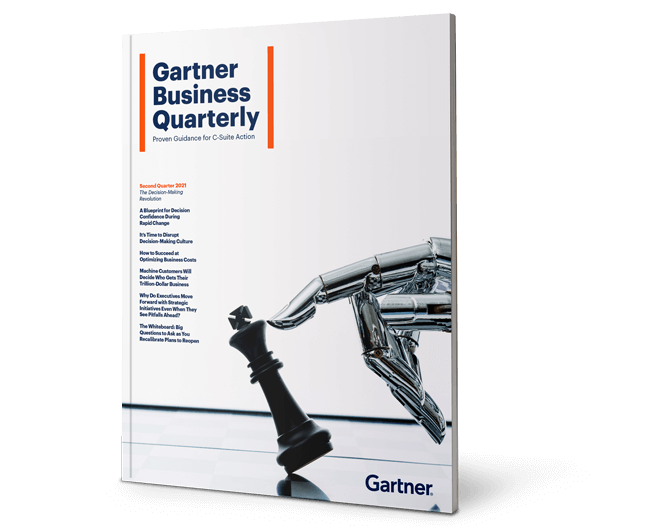- Gartner client? Log in for personalized search results.
Proven guidance for C-suite action
2021 Q2
The Decision-Making Revolution
Drive high quality decision-making amid rapid changes
Functional leaders tell us in survey after survey about their growing doubts to make wise choices and tough calls. They need to make bigger and faster decisions than just two years ago; and they must involve more colleagues. They acknowledge the importance of data yet admit to relying on their guts.
This issue of Gartner Business Quarterly (GBQ) lays out the elements of a much-needed decision making revolution to help functional leaders increase confidence in their choices amid a rapidly changing world.
In this issue
A Blueprint for Decision Confidence During Rapid Change
Discover five quality markers for functional leaders to make the right call and drive strategic value during times of uncertainty.
It’s Time to Disrupt Decision-Making Culture
See how functional leaders can reorient decision-making with data literate teams and roles working in close collaboration with machines.
How to Succeed at Optimizing Business Costs
Only 35% of executives use cross-functional frameworks to guide consistent spending decisions. But those who do collaborate across the C-suite were less likely to report pandemic-related budget cuts.
Machine Customers Will Decide Who Gets Their Trillion-Dollar Business
Learn how executive leaders plan to sell to machines that make purchase decisions differently than people do.
Why Do Executives Move Forward With Strategic Initiatives Even When They See Pitfalls Ahead?
Recognize the signs of overconfidence that mean you may be stretching the business or the initiative too far.
Map Your Way to Leaner Big-Bet Proposals
To evaluate the cost of unfamiliar initiatives, discover the benefits of a visual framework and review process to get everyone speaking the same language.
ERM Teams Help Stakeholders Make Sense of Risk Information to Combat Overload
See how successful ERM teams enable decisions by getting the most relevant information and applying it correctly.
Finance Can Help the Business See Beyond P&L With the Aid of Accounting and Treasury Staff
Finance leaders can tap technical staff to help decision makers see how the balance sheet and middle office can support the business.
Impose Constraints to Make Better Decisions Faster
To achieve better outcomes with less effort, define limitations around decision making to create structure, urgency and efficiency.
The Whiteboard: Big Questions to Ask as You Recalibrate Plans to Reopen
Discover the latest developments — such as the vaccine rollout, changing COVID-19 science, and a year’s experience with remote work.
Letter Title
Letter From the Editor
Leaders in function after function tell us in survey after survey about their growing doubts that they can make wise choices and tough calls. They say they need to make bigger decisions and faster decisions than just two years ago; they say they must involve more colleagues. They acknowledge the importance of data yet admit to relying on their gut. They say they seek out evidence their bosses want to hear.
This is an unhealthy state of affairs. Just as machine learning needs algorithms, people need systems and frameworks that support higher quality decision making. And organizations must retool their cultures to make these processes more transparent, more collaborative, more timely.
The short articles inside will offer help. You’ll learn the five markers of decision-making excellence and tips for attaining each one. You’ll get advice for spreading data literacy. And you’ll read about an emerging market—products that order their own refills and repairs— that you can capitalize on only once you understand how machines decide what to buy.
You’ll find real-world experience shared by leaders at an international group of organizations, large and midsize, private and public, including CHS, DSM, Danfoss, Dropbox, Bose, Benco Dental, UnitedHealth Group and Froedtert & the Medical College of Wisconsin.
GBQ advises you on aligning with others and reaching peak effectiveness, so your organization can achieve its goals, be bold and principled, and bring employees, investors and the public along for the ride.
Our standing departments keep you up to speed — Cutting Edge, a look at provocative new data, and Briefs, short takes about smarter spending and planning, talent and culture, growth and innovation, and data and technology.
We welcome your feedback. Please contact me at judy.pasternak@gartner.com.
— Judy Pasternak
For Most CEOs, Taking a Public Social Justice Stance Seems Risky
Only 39% are confident that commenting externally is good for business. That leaves 61% of CEOs unsure of the value of expressing a position.
CEOs Have Quietly Reduced Their Digital Business Ambitions
CEOs language shows a shift toward operations. Compared with last year, mentions of digital transformation halved, digitalization tripled, and e-commerce and digital commerce quadrupled.
This issue of Gartner Business Quarterly contains insights from the practical experience of:
- Benco Dental
- Bose
- CHS
- QBE North America
- Colgate-Palmolive
- Danfoss
- Dropbox
- DSM
- Eastman Chemical
- Froedtert & the Medical College of Wisconsin
- Philips
- Schneider Electric
- UnitedHealth Group
About Gartner Business Quarterly
Gartner Business Quarterly provides business executives with insights from best practices research and the real-world experience of practitioners. The journal’s insights especially equip executives to tackle challenges that cut across the C-suite and affect multiple executive teams. Writers, contributors and data analysts are members of Gartner Research & Advisory (R&A), whose teams are led by Executive VP Mike Harris. The Gartner Business Quarterly publication is led by Editor-in-Chief Judy Pasternak, with executive sponsorship by Group VP Scott Christofferson.
Recent Issues

Employee-Centered Paths to Business Growth
Manage teams effectively through times of crisis

The Resilient Enterprise
Strength and agility to lead through disruption




